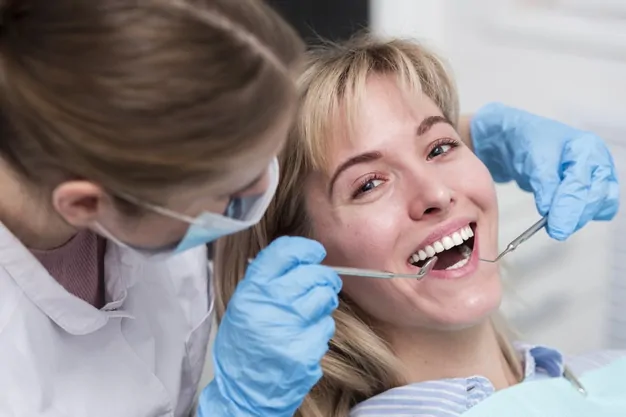
In the realm of dental health, myths and misconceptions often circulate like wildfire, leaving many unsure about the best practices for maintaining optimal oral hygiene. It’s time to put an end to these dental myths by shedding light on the truth and providing evidence-based insights. Let’s delve into six common dental myths, debunking them one by one.
Myth 1: Whitening Toothpaste Can Replace Professional Teeth Whitening
Related Keywords: whitening toothpaste, professional teeth whitening, teeth discoloration
In pursuit of that radiant smile, many individuals turn to whitening toothpaste with the hope that it will single-handedly eliminate stubborn teeth stains. However, the reality is quite different. Whitening toothpaste can help with surface-level stains to some extent, but it’s not a substitute for professional teeth whitening procedures. These over-the-counter toothpastes contain mild abrasives that can remove minor stains, but deep-seated discoloration requires the expertise of a dental professional. Professional teeth whitening treatments, such as in-office bleaching or take-home trays provided by dentists, are tailored to address specific discoloration issues, ensuring more effective and lasting results.
Myth 2: Sugar is the Sole Culprit Behind Cavities
Related Keywords: sugar, cavities, dental decay, oral hygiene
Blaming sugar as the lone villain responsible for cavities oversimplifies the complex process of dental decay. While sugar certainly plays a role, cavities are the result of a combination of factors. When sugary or starchy foods are consumed, they interact with the bacteria in the mouth to produce acids. These acids, along with bacteria and food particles, form plaque, which gradually erodes tooth enamel, leading to cavities. It’s essential to practice good oral hygiene, including regular brushing, flossing, and dental check-ups, to prevent cavities effectively. Cutting down on sugar intake is just one part of the equation.
Myth 3: Brushing Aggressively Yields Cleaner Teeth
Related Keywords: aggressive brushing, tooth enamel, oral health, proper brushing technique
The notion that applying excessive pressure while brushing will result in cleaner teeth is a misconception that needs to be dispelled. Aggressive brushing can actually harm your teeth and gums. Tooth enamel is resilient but not invulnerable; aggressive brushing can wear it down over time, leading to tooth sensitivity and an increased risk of cavities. Additionally, harsh brushing can irritate and damage the gums, causing them to recede. Instead, opt for a gentle yet thorough brushing technique using a soft-bristle toothbrush. Remember to brush for at least two minutes, reaching all tooth surfaces and massaging the gums gently.
Myth 4: Natural Remedies Alone Can Treat Gum Disease
Related Keywords: natural remedies, gum disease, periodontal health, professional dental treatment
The allure of natural remedies for treating gum disease is enticing, but it’s important to recognize their limitations. While certain natural ingredients like tea tree oil, aloe vera, and oil pulling may offer mild benefits for gum health, they are not a substitute for professional dental intervention. Gum disease, also known as periodontal disease, can range from mild gingivitis to severe periodontitis, requiring targeted treatments that address the root cause. Dentists possess the expertise and tools to diagnose and treat gum disease effectively, which may involve deep cleaning, scaling, and in some cases, surgical procedures. Relying solely on natural remedies can allow the condition to worsen, leading to irreversible damage.
Myth 5: Baby Teeth Care Is Inconsequential
Related Keywords: baby teeth, primary teeth, pediatric dental care, oral development
Some parents mistakenly believe that since baby teeth are temporary, their care is of little importance. However, neglecting baby teeth can have lasting repercussions. Baby teeth serve as placeholders for adult teeth, aiding in proper oral development. Untreated cavities or infections in baby teeth can affect the eruption of permanent teeth, leading to misalignment issues. Moreover, instilling good oral hygiene habits from a young age sets the foundation for a lifetime of healthy dental practices. Regular dental check-ups for children are crucial to monitor oral development, address any concerns, and promote positive oral hygiene routines.
Myth 6: Mouthwash Alone Suffices for Comprehensive Oral Care
Related Keywords: mouthwash, oral care, dental hygiene, mouthwash limitations
Mouthwash undoubtedly provides a refreshing sensation and can temporarily mask bad breath, but it should not be considered a standalone solution for comprehensive oral care. Mouthwash can complement brushing and flossing, but it cannot replace them. Mechanical actions like brushing and flossing physically remove plaque and food particles, while mouthwash primarily offers a chemical rinse. Additionally, not all mouthwashes are created equal; some are designed for specific purposes, such as reducing plaque, freshening breath, or addressing gingivitis. Consult with a dentist to determine which mouthwash suits your individual needs, and remember that it should be used in conjunction with a complete oral hygiene routine.
Conclusion
Debunking viral dental myths is essential for maintaining proper oral health and preventing misinformation from spreading. While it’s easy to fall for popular beliefs, it’s crucial to rely on evidence-based practices endorsed by dental professionals. Remember, achieving and maintaining a healthy smile requires a combination of consistent oral hygiene, regular dental visits, and informed decision-making.
So, the next time you encounter dental myths circulating online or among friends, you’ll be armed with the knowledge to distinguish fact from fiction and pave the way for stronger, healthier teeth.
